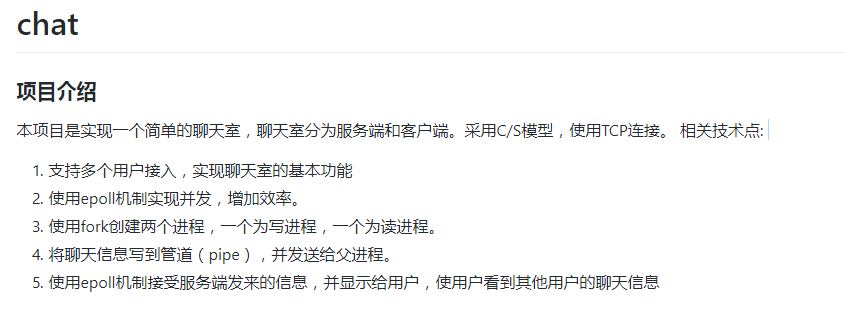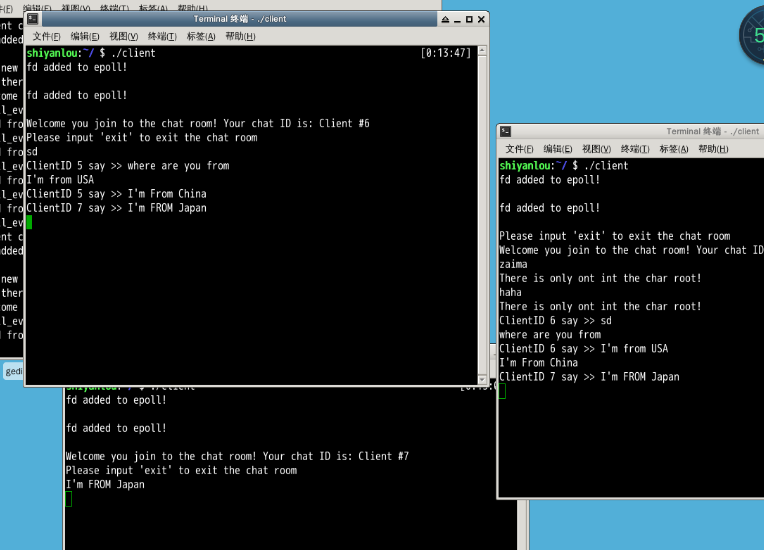2019-11-19
00:19:02
参考大佬:https://github.com/LinHaoo/chat


Makefile:
all:server client server:server.cpp g++ $^ -o $@ client:client.cpp g++ $^ -o $@ clean: rm server client
utility.h
#ifndef CHAT_UTILITY_H #define CHAT_UTILITY_H #include <iostream> #include <list> #include <sys/types.h> #include <sys/socket.h> #include <netinet/in.h> #include <arpa/inet.h> #include <sys/epoll.h> #include <fcntl.h> #include <errno.h> #include <unistd.h> #include <stdio.h> #include <stdlib.h> #include <string.h> using namespace std; //clients_list save all the clients's socket list<int> clients_list; /***** macro defintion *****/ //server ip #define SERVER_IP "127.0.0.1" //server port #define SERVER_PORT 8888 //epoll size #define EPOLL_SIZE 5000 //message buffer size #define BUF_SIZE 0xFFFF #define SERVER_WELCOME "Welcome you join to the chat room! Your chat ID is: Client #%d" #define SERVER_MESSAGE "ClientID %d say >> %s" //exit #define EXIT "EXIT" #define CAUTION "There is only ont int the char root!" /****** some function *****/ /** *设置非阻塞 */ int setnonblockint(int sockfd) { fcntl(sockfd, F_SETFL, fcntl(sockfd, F_GETFD, 0) | O_NONBLOCK); return 0; } /** * 将文件描述符 fd 添加到 epollfd 标示的内核事件表中, * 并注册 EPOLLIN 和 EPOOLET 事件, * EPOLLIN 是数据可读事件;EPOOLET 表明是 ET 工作方式。 * 最后将文件描述符设置非阻塞方式 * @param epollfd:epoll句柄 * @param fd:文件描述符 * @param enable_et:enable_et = true, * 是否采用epoll的ET(边缘触发)工作方式;否则采用LT(水平触发)工作方式 */ void addfd(int epollfd, int fd, bool enable_et) { struct epoll_event ev; ev.data.fd = fd; ev.events = EPOLLIN; if (enable_et) { ev.events = EPOLLIN | EPOLLET; } epoll_ctl(epollfd, EPOLL_CTL_ADD, fd, &ev); setnonblockint(fd); printf("fd added to epoll! "); } //发送广播 int sendBroadcastmessage(int clientfd) { char buf[BUF_SIZE]; char message[BUF_SIZE]; bzero(buf, BUF_SIZE); bzero(buf, BUF_SIZE); printf("read from client(clientID = %d) ", clientfd); int len = recv(clientfd, buf, BUF_SIZE, 0); if (0 == len) { close(clientfd); clients_list.remove(clientfd); printf("ClientID = %d closed. now there are %d client in the char room ", clientfd, (int)clients_list.size()); } else { if (1 == clients_list.size()) { send(clientfd, CAUTION, strlen(CAUTION), 0); return 0; } sprintf(message, SERVER_MESSAGE, clientfd, buf); list<int>::iterator it; for (it = clients_list.begin(); it != clients_list.end(); ++it) { if (*it != clientfd) { if (send(*it, message, BUF_SIZE, 0) < 0) { perror("error"); exit(-1); } } } } return len; } #endif //CHAT_UTILITY_H
client.cpp
#include "utility.h" #define error(msg) do {perror(msg); exit(EXIT_FAILURE); } while (0) int main(int argc, char *argv[]) { /** * TCP 客户端通信 * 1.创建套接字(socket) * 2.使用 connect() 建立到达服务器的连接(connect) * 3.客户端进行通信(使用 write()/send() 或 send()/recv() ) * 4.使用 close() 关闭客户连接 */ /** * 1:创建套接字socket * param1:指定地址族为IPv4;param2:指定传输协议为流式套接字;param3:指定传输协议为TCP,可设为0,由系统推导 */ int clientfd = socket(PF_INET, SOCK_STREAM, IPPROTO_TCP); if (clientfd < 0) { error("socket error"); } // 填充sockadd结构,指定ip与端口 struct sockaddr_in serverAddr; serverAddr.sin_family = AF_INET; serverAddr.sin_port = htons(SERVER_PORT); serverAddr.sin_addr.s_addr = inet_addr(SERVER_IP); // 2:连接服务端 if (connect(clientfd, (struct sockaddr *) &serverAddr, sizeof(serverAddr)) < 0) { error("connect error"); } // 创建管道,其中fd[0]用于父进程读,fd[1]用于子进程写 int pipefd[2]; if (pipe(pipefd) < 0) { error("pipe error"); } /** * epoll使用 * 1:调用 epoll_create 函数在 Linux 内核中创建一个事件表; * 2:然后将文件描述符添加到所创建的事件表中 (epoll_ctl); * 3:在主循环中,调用 epoll_wait 等待返回就绪的文件描述符集合; * 4:分别处理就绪的事件集合 */ // 创建epoll int epfd = epoll_create(EPOLL_SIZE); if (epfd < 0) { error("epfd error"); } static struct epoll_event events[2]; //将sock和管道读端描述符都添加到内核事件表中 addfd(epfd, clientfd, true); addfd(epfd, pipefd[0], true); // 表示客户端是否正常工作 bool isClientwork = true; // 聊天信息缓冲区 char message[BUF_SIZE]; // Fork int pid = fork(); if (pid < 0) { error("fork error"); } else if (pid == 0) { // 子进程 //子进程负责写入管道,因此先关闭读端 close(pipefd[0]); printf("Please input 'exit' to exit the chat room "); while (isClientwork) { bzero(&message, BUF_SIZE); fgets(message, BUF_SIZE, stdin); // 客户输出exit,退出 if (strncasecmp(message, EXIT, strlen(EXIT)) == 0) { isClientwork = 0; } else { // 子进程将信息写入管道 if (write(pipefd[1], message, strlen(message) - 1) < 0) { error("fork error"); } } } } else { //pid > 0 父进程 //父进程负责读管道数据,因此先关闭写端 close(pipefd[1]); // 主循环(epoll_wait) while (isClientwork) { // 等待事件的产生,函数返回需要处理的事件数目 int epoll_events_count = epoll_wait(epfd, events, 2, -1); // 处理就绪事件 for (int i = 0; i < epoll_events_count; ++i) { bzero(&message, BUF_SIZE); //服务端发来消息 if (events[i].data.fd == clientfd) { //接受服务端消息 int ret = recv(clientfd, message, BUF_SIZE, 0); // ret= 0 服务端关闭 if (ret == 0) { printf("Server closed connection: %d ", clientfd); close(clientfd); isClientwork = 0; } else printf("%s ", message); } //子进程写入事件发生,父进程处理并发送服务端 else { //父进程从管道中读取数据 int ret = read(events[i].data.fd, message, BUF_SIZE); // ret = 0 if (ret == 0) { isClientwork = 0; } else { // 将信息发送给服务端 send(clientfd, message, BUF_SIZE, 0); } } }//for }//while } if (pid) { //关闭父进程和sock close(pipefd[0]); close(clientfd); } else { //关闭子进程 close(pipefd[1]); } return 0; }
server.cpp
#include "utility.h" #define error(msg) do {perror(msg); exit(EXIT_FAILURE); } while (0) int main(int argc, char *argv[]) { /** * TCP服务端通信 * 1:使用 socket()创建 TCP 套接字(socket) * 2:将创建的套接字绑定到一个本地地址和端口上(bind) * 3:将套接字设为监听模式,准备接收客户端请求(listen) * 4:等待客户请求到来: 当请求到来后,接受连接请求,返回一个对应于此次连接的新的套接字(accept) * 5:用 accept 返回的套接字和客户端进行通信(使用write()/send()或send()/recv()) * 6:返回,等待另一个客户请求 * 7:关闭套接字 */ /** * 1:创建套接字socket * param1:指定地址族为IPv4;param2:指定传输协议为流式套接字;param3:指定传输协议为TCP,可设为0,由系统推导 */ int listener = socket(PF_INET, SOCK_STREAM, IPPROTO_TCP); if (listener < 0) { error("socket error"); } printf("listen socket created "); //地址复用 int on = 1; if (setsockopt(listener, SOL_SOCKET, SO_REUSEADDR, &on, sizeof(on)) < 0) { error("setsockopt"); } struct sockaddr_in serverAddr; serverAddr.sin_family = PF_INET; serverAddr.sin_port = htons(SERVER_PORT); serverAddr.sin_addr.s_addr = inet_addr(SERVER_IP); //绑定地址 if (bind(listener, (struct sockaddr *) &serverAddr, sizeof(serverAddr)) < 0) { error("bind error"); } //监听 if (listen(listener, SOMAXCONN) < 0) { error("listen error"); } printf("Start to listen: %s ", SERVER_IP); //在内核中创建事件表 int epfd = epoll_create(EPOLL_SIZE); if (epfd < 0) { error("epfd error"); } printf("epoll created, epollfd = %d ", epfd); static struct epoll_event events[EPOLL_SIZE]; //往内核事件表里添加事件 addfd(epfd, listener, true); //主循环 while (1) { //epoll_events_count表示就绪事件的数目 int epoll_events_count = epoll_wait(epfd, events, EPOLL_SIZE, -1); if (epoll_events_count < 0) { perror("epoll failure"); break; } printf("epoll_events_count = %d ", epoll_events_count); //处理这epoll_events_count个就绪事件 for (int i = 0; i < epoll_events_count; ++i) { int sockfd = events[i].data.fd; //新用户连接 if (sockfd == listener) { struct sockaddr_in client_address; socklen_t client_addrLength = sizeof(struct sockaddr_in); int clientfd = accept(listener, (struct sockaddr *) &client_address, &client_addrLength); printf("client connection from: %s : % d(IP : port), clientfd = %d ", inet_ntoa(client_address.sin_addr), ntohs(client_address.sin_port), clientfd); addfd(epfd, clientfd, true); // 服务端用list保存用户连接 clients_list.push_back(clientfd); printf("Add new clientfd = %d to epoll ", clientfd); printf("Now there are %d clients int the chat room ", (int) clients_list.size()); // 服务端发送欢迎信息 printf("welcome message "); char message[BUF_SIZE]; bzero(message, BUF_SIZE); sprintf(message, SERVER_WELCOME, clientfd); int ret = send(clientfd, message, BUF_SIZE, 0); if (ret < 0) { error("send error"); } } else { //处理用户发来的消息,并广播,使其他用户收到信息 int ret = sendBroadcastmessage(sockfd); if (ret < 0) { error("error"); } } } } close(listener); //关闭socket close(epfd); //关闭内核 return 0; }
